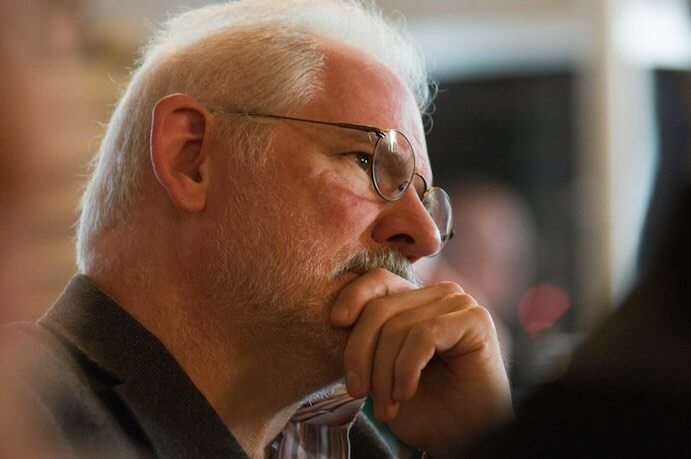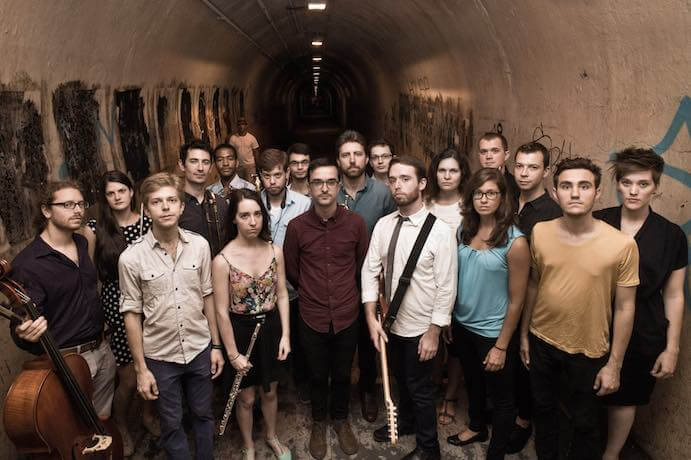The air at Roulette was permeated by unusual musical lines and shapes on April 11, 2017, as new music ensemble Contemporaneous presented four world premieres, all of which incorporated tunings and temperaments outside the Western norm of “equal temperament.” The evening featured the revised version of an intricate work by Katherine Balch, as well as lively works by three commissioned composers: Shawn Jaeger, Kyle Gann, and Kristofer Svensson. These four works ranged in style and structure, but were united not only by their unusual tunings but their spotless rendering on the part of the 21-member ensemble, led by the graceful sensitivity of conductor David Bloom. Bloom and cellist Dylan Mattingly, the co-artistic directors of Contemporaneous, explained in between pieces that they strive to bring unique experiences to audience’s ears; their program of “transcendental geometry” presented a delightfully unconventional palette of spiky microtones, piquant harmonies, and smudgy temporalities.
Katherine Balch‘s New Geometry (2016, rev. 2017) is inspired by Tom Stoppard’s play Arcadia, as according to Balch “pretty much all my music is about that play.” Balch spoke of the “interlocking dense structures” found not only in nature but in human relationships, as the characters in the play are shown to have resonance across space and time. Balch’s exquisite sound world in the first moments of the piece was constituted by layers of airy, fluttery sounds brushed across surfaces and across the strings inside the piano. Eventually, these flutters surged into a series of rushing, overlapping descending runs and patterns sliding this way and that, against a muted trombone in the background, until the final upward lilty wisp of sound. This passage from sparseness to chaos was mirrored by the harmonic passage from microtonality to chromaticism and diatonicism.

Katherine Balch–Photo by KateL Photography
Similarly inspired by interlocking structures, yet radically different in its execution, was Shawn Jaeger‘s Wilderness of Woe (2017). The piece was inspired by bluegrass music, but for the most part sounds nothing like it, because Jaeger had slowed down the bluegrass tunes 200 times before incorporating them into his work. Jaeger stated that he was drawn to the interlocking sounds he heard within bluegrass, such as the way a violin would attack a note, and decided to use these raw, disconnected moments as material rather than the tunes themselves. Not interested in “complexity for complexity’s sake,” he used temporal manipulation to slow down and smear the tunes into long tones overlaid with xylophone twinklings and punctuated by wood block clicks. Sudden snapshots of bluegrass melodies were interrupted by applause from the musicians themselves, a comedic and texturally fascinating touch. Once the first movement has trailed off into a brief silence, the second movement’s bleary blurriness began. Although there were nice moments to be found here, the piece would have been just as effective if kept to a single movement.
The centerpiece of the evening was Kyle Gann‘s Cap Rock Wind (2016), a work for chamber orchestra and soprano set to excerpts from Woody Guthrie’s novel House of Earth. Gann introduced the piece with an awkward Trump joke and an explanation of this piece as his first he had composed about his home state of Texas; he intended to indicate “the depressing flipside” to Copland’s Appalachian Spring. Soprano Lucy Dhegrae was extremely adept at bringing to life not only Guthrie’s text but also Gann’s captivating vocal lines, while the ensemble itself navigated the tapestry of polyrhythms with ease. The churning chopped repetitions evoked the dry Texas landscape, while guitar and saxophone timbres contributed to this Western sound world. The Reichian repetitions and sweeping strings were pleasant, but ultimately the work felt somewhat bland compared to the other offerings on the program, and to other compositions in Gann’s wide-ranging oeuvre.

Kyle Gann
Kristofer Svensson‘s Si beatitudo aeterna non est malo in somniis versati (2016) rounded out the evening. Svensson explained that he wanted to engender “a kind of close listening via just intonation” with this piece, although typically he doesn’t even mention the fact that his music is composed in just intonation, as he fears that will shape the audience’s listening too much. For my part, knowing a bit about his compositional emphasis allowed for the kind of “close listening” that seemed to be desired. Svensson’s pointillistic vocal and instrumental tones reminded me of John Cage’s choral works as they materialized into a sort of fragmented chorale. These dreamy shreds and slivers of sound gradually coalesced into a lush blend of tones and textures, with wind players blowing into their instruments, before the eventual dissolution into silence.




















